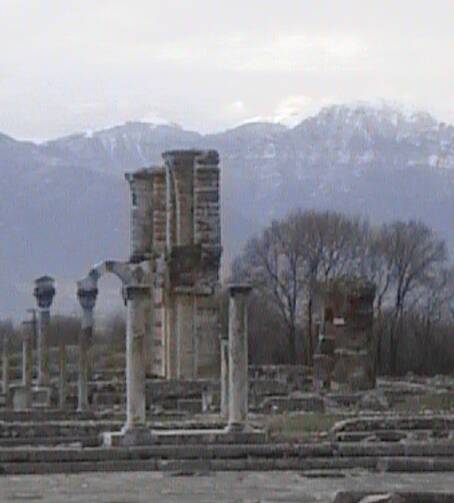In the first installment, I set out the traditional Greco-Roman letter format and looked at the “Judases” and “Jameses” in the New Testament. In the second installment, I weighed the arguments on authorship and decided the best evidence points in the direction of the Judas/Jude who is the brother of Jacob/James and Jesus. I then looked at what this means for the date of the letter and the location, or place, in which the letter was written. In the third installment, I examined the salutation, verses 1-2, in which I studied the letter itself, the reasons the letter was sent, and the goals of the letter.In the fourth installment I studied the “Reason for Writing” in verses 3-4, a part of the letter typically called the “Thanksgiving,” but in Jude lacking that element. In the fifth entry, verses 5-7, I studied the first three charges Jude makes against the “intruders.” In the sixth entry, verses 8-10, I looked at how Jude applies the charges made against the intruders. For the seventh entry, I considered the further charges against these intruders and “dreamers” taken from the Old Testament, and an actual charge made regarding their behavior in the community. We encountered some prophetic charges against the intruders in the eighth entry, but in the ninth installment we find Jude focused on exhorting and building up the recipients of the letter.
6. The Letter of Jude:
To see the breakdown of a typical Greco-Roman letter, the category into which Jude fits, please consult the first entry in the commentary. We have now come to the end of the Body of the Letter, which is “hortatory” or an exhortation of the recipients. The letter of Jude is concentrated for the most part on the denunciation of the “intruders” and “dreamers” who have troubled this particular church (or churches), but now Jude switches his attention to the recipients who have remained faithful adherents. Interestingly, however, is that is in this exhortation Jude’s attention also switches from denunciation of the “intruders” to a desire to reconcile them and those they have influenced with the community.
d) Body of the Letter: Exhortation to Faithfulness and Steadfastness: verses 20-23
20 But you, beloved, build yourselves up on your most holy faith; pray in the Holy Spirit; 21 keep yourselves in the love of God; look forward to the mercy of our Lord Jesus Christ that leads to eternal life. 22 And have mercy on some who are wavering; 23 save others by snatching them out of the fire; and have mercy on still others with fear, hating even the tunic defiled by their bodies. (NRSV)
The exhortation is such a welcome change in the letter of Jude, as the tension seems to dissipate, even if the problems have not yet been solved. Jude tells the Church in v. 20 to “build yourselves up on your most holy faith” (epoikodomountes), which as J.N.D. Kelly points out utilizes a common image found elsewhere in the NT of the “body of Christian believers as a building or temple” (Kelly, 285; see 1 Cor. 3:9-17; Eph. 2:20-22; 1 Peter 2:5). “Your most holy faith” must certainly be a reference back to the “faith” of verse 3 for which they have been told to contend. This was discussed in entry 4 where I described how Jude is encouraging the Christians with this letter to maintain the traditional faith passed on to them, though his initial intent had been to discuss their “common salvation.” The situation was significant enough to entail a change of topic and Jude uses the language of “contending” for the faith in verse 3, which evokes athletic contests and the need to win this battle. At the end of this letter, Jude can now focus on the more sedate image of “building up,” since he seems secure that they will indeed maintain their faith.
They are also told in v. 20 to “pray in the Holy Spirit,” an exhortation that is found throughout Paul’s letters (Eph. 6:18; Rom. 8:26f; 1 Cor. 12:3; Gal. 4:6). Prayer in itself is reason enough for the exhortation, but in the previous verse the intruders have been described as “devoid of the Spirit,” so this appeal also draws a contrast between the behavior of those who intruded upon the Church and those who have remained faithful. It is a thorny issue for the early Christians, because the Holy Spirit is guiding the Church. An appeal to the Spirit should not be simply dismissed. But as we see in 1 John, many people appealed to the “Spirit” to support beliefs otherwise unattested, but Jude, like 1 John, links the Spirit to behavior. It is on the grounds of behavior that claims to the Spirit are rejected.
The Church is also called in v. 21 “to keep yourselves in the love of God.” Kelly points out that the verb for “keep” (têrein) is a favorite of Jude, used 4 times elsewhere in the letter (Kelly, 286). He also draws another comparison to Johannine literature, namely, that in John 15:9 and 1 John 2:5-6, as examples, “abiding” in Christ’s love is connected to proper behavior. “To keep” oneself in God’s love, therefore, probably has the tangible sense of doing the commandments. They are also told to “look forward to the mercy of our Lord Jesus Christ that leads to eternal life.” This turns their gaze to the future reward, when so much of the letter has focused on future punishment. The key word here is “mercy,” which is the necessary component for eternal life, even those who have more fully lived out the Christian life.
The unexpected turn is now to those who have been attracted by the “intruders’” teaching, and possibly the “intruders” themselves. The believers are told to “have mercy on some who are wavering” (v. 22). Mercy has just been invoked in v. 21 as the key to their salvation, that is, the mercy of Christ, and now they are told to show mercy on a group of those who are “wavering.” Those who are wavering are probably attracted by the teachers with whom Jude has been so worried, but instead of treating them with disdain or justice, they are told to have mercy, which concretely might simply mean to welcome them back into the community. A second group is to be saved “snatching them out of the fire” (v.23). The “fire” here must indeed mean the fire of damnation, found throughout the NT and, of course, in 1 Enoch; how they are to be snatched out of the fire is not described. [1] It is interesting that in describing the follies of the “intruders,” and in describing how those attracted to the “intruders” are to be saved, there is little solid advice. This might be because Jude’s seemingly general advice would have had a perceptible context for those who received it or because Jude did not want to be too specific for reasons which are lost to us. Either way, it makes it difficult to reconstruct the situation.
Finally, the Church is called to “have mercy on still others with fear, hating even the tunic defiled by their bodies” (v.23). The “fear” here must have the sense of “reverent awe,” the fear of God, which is found throughout the Bible. Is such mercy, when one is called to have “fear” and to “hate” even the tunic defiled by their bodies, simply leaving these people alone? If one cannot come near the tunic, the cloth, how can one even come near the person? For this reason, I think it is possible that in this verse Jude could be describing how to deal with the actual “intruders.” The likeliest meaning is just to stay away from them or to approach with extreme caution, which makes it unlikely that they are community members simply attracted by the teaching of the “intruders.”
One final connection should be made and that is between vv.22-23 and Zechariah 3:1-5, a comparison drawn by Reicke (216), Schreiner (489) and Gonzalez (225). More than that, Gonzalez draws a connection Jude 22-23, Zechariah 3:3-5 and 1 Enoch. First, I will cite the passage from Zechariah and then Gonzalez’s comments. Zechariah writes,
Then he showed me the high priest Joshua standing before the angel of the Lord, and Satan standing at his right hand to accuse him. And the Lord said to Satan, "The Lord rebuke you, O Satan! The Lord who has chosen Jerusalem rebuke you! Is not this man a brand plucked from the fire?" Now Joshua was dressed with filthy clothes as he stood before the angel. 4 The angel said to those who were standing before him, "Take off his filthy clothes." And to him he said, "See, I have taken your guilt away from you, and I will clothe you with festal apparel." 5 And I said, "Let them put a clean turban on his head." So they put a clean turban on his head and clothed him with the apparel; and the angel of the Lord was standing by. (Zechariah 3:1-5)
About this passage, Catherine Gonzalez says, “the imagery in verses 22 and 23 reflects Zechariah 3:1-5. This is the passage quoted by the archangel Michael in 1 Enoch, asking that God rebuke Satan, the passage Jude had referred to in verse 9” (225). This is fascinating simply at the level of connecting 1 Enoch to this short letter once again. In terms of content, however, the association might be to Joshua’s filthy clothes in Zechariah and Jude’s “tunic defiled by their bodies.” In Zechariah, even though Satan has accused Joshua, the angel(s) take off Joshua’s filthy clothes and put new clothes on him. Could this represent hope for those in defiled tunics? Could taking the tunic off represent baptism? If this is the case, maybe there is greater hope for the "intruders" than the verse seems initially to suggest. Perhaps “mercy on still others with fear” evokes more hopefulness than it initially appears. This might be a stretch too far, but the imagery is evocative.
Next week: the ending of Jude.
John W. Martens
I invite you to follow me on Twitter @Biblejunkies
This entry is cross-posted at Bible Junkies
[1] Kelly actually connects this clause with the previous verse, that is, he would say the exhortation is to “have mercy on some who are wavering, by snatching them out of the fire” (this is my paraphrase). This would mean that one group is described by verse 22 and the first part of verse 23 and not two separate groups as I understand it. This is based on textual traditions going back to the ancient Church and ancient manuscripts. Kelly opts for the textual tradition which sees only two groups in this section (there is still a group to be described in v. 23 which would make two in total when added to this group), while I opt for the textual tradition adopted by the NRSV and NAB which sees three groups in total, namely, the two just described and one yet to come in v. 23.








